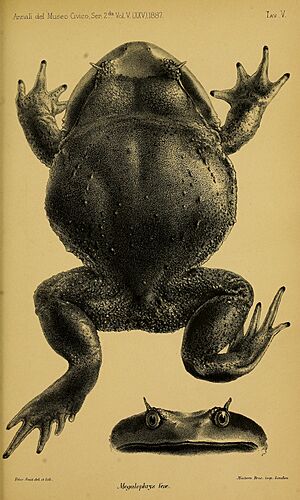Brachytarsophrys feae facts for kids
Quick facts for kids Brachytarsophrys feae |
|
|---|---|
 |
|
| Conservation status | |
| Scientific classification | |
| Synonyms | |
|
Megalophrys feae Boulenger, 1887 |
Fea's horned frog (scientific name: Brachytarsophrys feae) is a special kind of amphibian, which means it's an animal that can live both on land and in water, like frogs and toads. It belongs to a family of frogs called Megophryidae.
You can find this frog in parts of southern China, northern Myanmar, Thailand, and Vietnam. It might also live in Laos. The name feae was given to honor Leonardo Fea, an Italian explorer and naturalist who studied animals.
Meet Fea's Horned Frog
Fea's horned frogs are quite large for frogs. Male frogs can grow to be about 9.6 centimeters (almost 4 inches) long. Female frogs are even bigger, reaching about 10.1 centimeters (about 4 inches) in length.
Even though the adult frogs are big, their babies, called tadpoles, are much smaller. Tadpoles are usually around 3.9 centimeters long.
Frog Behavior
Male Fea's horned frogs seem to be quite protective of their space. They are known to be territorial, meaning they defend their living area from other frogs.
When a male frog wants to attract a mate, it makes a very loud call. This call sounds a lot like a dog barking! Scientists have noticed that these frogs usually make their loud calls only on rainy nights. At other times, the males prefer to stay hidden in their burrows, which are small tunnels they dig near streams.
Where They Live and How We Protect Them
Fea's horned frogs live in specific places in nature. Their favorite homes are evergreen broadleaf forests, which are forests that stay green all year round. They also love to be near streams. These streams are very important because that's where the frogs lay their eggs and where their tadpoles grow.
Sadly, these frogs face some challenges. Their homes are sometimes destroyed when people build dams or power plants. Also, some people collect these frogs to eat them. Because of these threats, it's important to protect their natural habitats so that Fea's horned frogs can continue to thrive.


